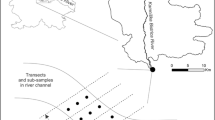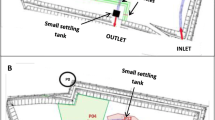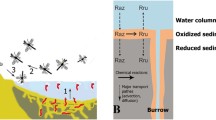Abstract
An exposure chamber, the “clambox”, was developed to measure ventilation rate, sediment processing rate, and efficiency of pollutant uptake by Macoma nasuta conrad, a surface deposit-feeding clam. Clams, collected from Yaquina Bay, Oregon, USA, were cemented into a hole in a piece of rubber dental dam so that the inhalant and exhalant siphons were separated by a membrane. The dental dam was then clamped between two glass chambers. The inhalant and exhalant siphons were thus directed into separate chambers of the device so that the amounts of water or feces discharged into the exhalant chamber provided direct measures of ventilation rate and sediment processing rate, respectively. Clams exhibited no stress from the procedure. Ventilation rate was not affected by the imposition of a 5 mm hydraulic head in the exhalant chamber, by having sediment only in the inhalant chamber, or by exposure to organic-free sediment. The mean weight-specific ventilation rate for M. nasuta was 7.3 ml g-1 h-1 on a wet-flesh basis. This low rate, compared to rates for filter-feeding bivalves, supports the contention that deposit-feeding is the dominant feeding mode for M. nasuta. The short-term pattern was for ventilation to be intermittenly interrupted, essentially ceasing for 12 to 120 min, followed by a short period of active ventilation and then a resumption of the normal rate. Less than 3% of the total water flux could be attributed to water which entered the body cavity across the mantle margin. Water exhaled from the inhalant siphon during the ejection of pseudofeces was <10% of the ventilation rate. The clambox technique should be adaptable to studies on other tellinid bivalves.
Similar content being viewed by others
Literature cited
Bayne, B. L., Newell, R. C. (1983). Physiological energetics of marine molluscs. In: Saleuddin, A. S. M., Wilbur, K. M. (eds.) The Mollusca, Vol. 4 (I). Academic Press, New York, p. 407–515
Boese, B. L. (1984). Uptake efficiency of the gills of English sole (Parophrys vetulus) for four phthalate esters. Can. J. Fish. aquat. Sci. 41:1713–1718
Boese, B. L., Lee, II, H., Specht, D. T. (1988). Efficiency of uptake of hexachlorobenzene from water by the tellinid clam, Macoma nasuta. Aquat. Toxicol. 12:345–356
Cammen, L. M. (1980). Ingestion rate: an empirical model for aquatic deposit feeders and detritivores. Oecologia 44:303–310
Coan, E. J. (1971). The Northwest American Tellinidae. Veliger (Suppl) 14:1–63
Coughlan, J. (1969). The estimation of filtering rate from the clearance of suspensions. Mar. Biol. 2:356–358
De Vias, J. (1979). Annual food intake by plaice and flounder in a tidal flat area in the Dutch Wadden Sea, with special reference to consumption of regenerating parts of macrobenthic prey. Neth. J. Sea Res. 13:117–153
Dixon, W. J. (Chief ed.) (1981). BMDP statistical software. University of California Press, Berkeley
Folk, R. L. (1980). Petrology of sedimentary rocks. Hemphill Publishing Co., Austin, Texas
Foster-Smith, R. L. (1975). The effect of concentration of suspension on the filtration rates and pseudofaecal production for Mytilus edulis L., Cerastoderma edule (L.) and Venerupis pullastra (Montagu). J. exp. mar. Biol. Ecol. 17:1–22
Foster-Smith, R. L. (1976). Some mechanisms for the control of pumping activity in bivalves. Mar. Behav. Physiol. 4:41–60
Galtsoff, P. S. (1926). New methods to measure the rate of flow produced by the gills of oyster and other molluscs. Science, N.Y. 63:233–234
Gile, J. D., Collins, J. C., Gillett, J. W. (1982). Fate and impact of wood preservatives in a terrestrial microcosm. J. Agric. Food Chem. 30:295–301
Goerke, H., Ernst, W. (1977). Fate of 14C-labelled di-, tri-, and pentachlorobiphenyl in the marine annelid Nereis virens. I. Accumulation and elimination after oral administration. Chemosphere 9:551–558
Harvey, R. W., Luoma, S. N. (1984). The role of bacterial exopolymer and suspended bacteria in the nutrition of the deposit-feeding clam, Macoma balthica. J. mar. Res. 42:957–968
Hildreth, D. I. (1976). The influence of water flow rate on the pumping rate in Mytilus edulis using a refined direct measurement apparatus. J. mar. biol. Ass. UK 56:311–319
Holme, N. A., McIntyre, A. D. (eds.) (1984). Methods for the study of the marine benthos. IBP Handbook No.16, 2nd edn p. 49
Hughes, R. N. (1969). A study of feeding in Scrobicularia plana. J. mar. biol. Ass. UK 49:805–823
Hummel, H. (1985). Food intake of Macoma balthica (mollusca) in relation to seasonal changes in its potential food on a tidal flat in the Dutch Wadeen Sea. Neth. J. Sea Res. 19(1):52–76
Hylleberg, J., Gallucci, V. F. (1975). Selectivity in feeding by the deposit-feeding bivalve Macoma nasuta. Mar. Biol. 32:167–178
Jørgensen, C. B. (1966). Biology of suspension feeding. Pergamon Press, Elmsford, New York
Jørgensen, C. B. (1975). Comparative physiology of suspension feeding. A. Rev. Physiol. 37:57–81
Karickhoff, S. W. (1984). Organic pollutant sorption in aquatic systems. J. Hydraul. Eng. 110:707–735
Kier, W. M. (1988). The arrangement and function of molluscan muscle. In: Wilbur, K. M. (ed.). The Mollusca. Vol. 11, Trueman, E. R., Clarke, M. R. (eds.) Form and function. Academic Press, New York, p. 235
Lee, II, H., Swartz, R. C. (1980). Biological processes affecting the distribution of pollutants in marine sediments. Part II, Biodeposition and bioturbation. In: Baker, R. A. (ed.) Contaminants and sediments. Ann Arbor Sci. Publ., Inc., Ann Arbor, 2:555–606
McKim, J. M., Goeden, H. M. (1982). A direct measure of the uptake efficiency of a xenobiotic chemical across the gills of brook trout (Salvelinus fontinalis) under normoxic and hypoxic conditions. Comp. Biochem. Physiol. 72C:65–74
Meyhöfer, E. (1985). Comparative pumping rates in suspension-feeding bivalves. Mar. Biol. 85:137–142
Møhlenberg, F., Riisgård, H. U. (1979). Filtration rate, using a new indirect technique, in thirteen species of suspension-feeding bivalves. Mar. Biol. 54:143–147
Moore, H. F. (1908). Volumetric studies of the food and feeding of oysters. Bull. U.S. Bur. Fish. 28:1297–1308
Morton, B. (1983). Feeding and digestion in bivalvia. In: Saleuddin, A. S. M., Wilbur, K. (eds.). The Mollusca. Academic Press, New York, 5(2):127–128
Nicol, J. A. C. (1967) The biology of marine animals. 2nd edn. John Wiley & Sons, Inc. New York, p. 163
Olafsson, E. B. (1986). Density dependence in suspension-feeding and deposit-feeding populations of the bivaive Macoma balthica: a field experiment. J. Anim. Ecol. 55:517–526
Peterson, C. H., Quammen, M. L. (1982). Siphon cropping: its importance to small fishes and its impact on the growth of the bivalve Protothaca staminea (Conrad). J. exp. mar. Biol. Ecol. 63:249–268
Rae, III, J. G. (1978). Reproduction in two sympatric species of Macoma (Bivalvia). Biol. Bull. mar. biol. Lab., Woods Hole 155:207–219
Reid, R. G. B., Reid, A. (1969). Feeding processes of members of the genus Macoma (Mollusca:Bivalvia). Can. J. Zool. 47:649–657
Sokal, R. R., Rohlf, F. J. (1981). Biometry. 2nd edn. W. H. Freeman and Co., San Francisco
Steel, R. G. D., Torrie, J. H. (1980). Principles and Procedures of Statistics: a biomedical approach. 2nd edn. McGraw-Hill, New York
Stekoll, M. S., Clement, L. E., Shaw, D. G. (1980). Sublethal effects of chronic oil exposure on the intertidal clam Macoma balthica. Mar. Biol. 57:51–60
Toulmond, A., Tchernigovtzeff, C. (1984). Ventilation and respiratory gas exchanges of the lugworm Arenicola marina (L.) as functions of ambient PO2 (20–700 torr). Respir. Physiol. 57:349–363
Williams, L.G. (1982). Mathematical analysis of the effects of particle retention efficiency on the determination of filtration rate. Mar. Biol. 66:171–177
Winer, B. J. (1961). Statistical principles in experimental design. McGraw-Hill, New York
Author information
Authors and Affiliations
Additional information
Communicated by J. P. Grassle, Woods Hole
Rights and permissions
About this article
Cite this article
Specht, D.T., Lee, H. Direct measurement technique for determining ventilation rate in the deposit feeding clam Macoma nasuta (Bivalvia, Tellinaceae). Mar. Biol. 101, 211–218 (1989). https://doi.org/10.1007/BF00391460
Accepted:
Issue Date:
DOI: https://doi.org/10.1007/BF00391460




